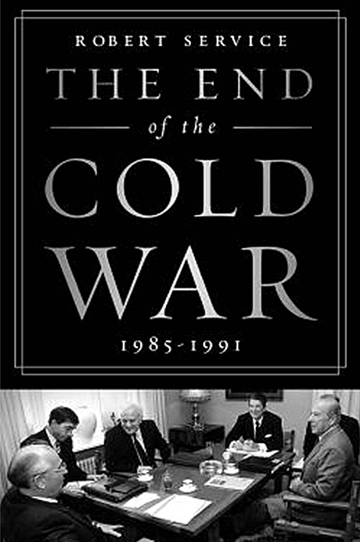
The End of the Cold War
December 8, 2015 | The Barnes & Noble Review
Who deserves credit: Reagan or Gorbachev? It is a question that drives many a book about the downfall of the Soviet Union. Yet to Robert Service, the eminent British historian of Soviet Russia, the question overlooks the complex and dynamic mechanics of history. In The End of the Cold War: 1985–1991, Service masterfully weaves a mosaic of individuals and events that toppled the Berlin Wall and brought down the USSR. He portrays Reagan and Gorbachev less as competitors in the zero-sum game of historical bow taking and more as rowers on opposite sides of the same boat. Both are remembered for their principle and vision, but Service contends they were driven as much by reaction to rapidly unfolding developments: The two were, in his words, “truly exceptional politicians working in cooperation in extraordinary times.”
The End of the Cold War ranges well beyond the era’s two leading men. Some of the best material precedes Gorbachev’s rise to power, when the corpse-like general secretaries Andropov and then Chernenko led the Soviet Union. Service vividly describes the latter as presenting “a dispiriting appearance”: racked with coughing fits, unable to command a podium, and quick to refer tough questions to his staff. Compared to the effortlessly charismatic Reagan, Chernenko was the visual embodiment of a dying nation.
There are many books on this topic, but Service’s exists because of the author’s access to Soviet archives, including the papers of senior members of the Communist Party. For this reason, The End of the Cold War focuses more on the Soviet than the American side. It gives the reader extraordinary glimpses into otherwise closed-off corridors of Kremlin power. For example, Service presents a detailed account of a Politburo meeting on November 3, 1989, when committee members faced a daunting agenda: the need for foreign grain because of weak agricultural production; ethnic conflict across the USSR; prickly relations with Pope John Paul II; the independence movement in East Berlin. Near the end of the book, Service quotes an apparatchik doing a bit of mild second-guessing that any bureaucrat will appreciate. About the restructuring of perestroika, this man asks: “So why generally did we need this?”
The End of the Cold War overflows with fascinating details. One of its best scenes has Chinese premier Deng Xiaoping receiving Vice President Bush early in the Reagan presidency, when the U.S. and USSR competed for Chinese favor. Deng tartly communicated his distaste for the new president — a vocal supporter of Taiwan — by spitting every time Reagan’s name was mentioned. During the famous Reykjavik summit in 1986, the American delegation held meetings inside a plastic bubble for fear of Russian surveillance. One member of the team, Richard Perle, needed more working space at his hotel, so he had a door unhinged and laid across a bathtub as a crude desk. Service presents the competing notes from the Americans and Russians about the final, bitter exchange between Reagan and Gorbachev after that summit failed to yield more progress. Each side unsurprisingly paints itself as the aggrieved party.
By the late ’80s, the Soviet Union was entering a death spiral. The combination of economic stagnation, internal reform led by Gorbachev, and agitation for independence in Eastern Europe led to irreversible change. One crisis followed another, as Poland, and then East Germany, and then, fatally, the Baltic states moved to break away from the motherland. When George H. W. Bush assumed the American presidency, his job was to manage this crisis. Although personally sympathetic toward Gorbachev, he refused the premier’s increasingly desperate requests for credit and launched a war against Saddam Hussein despite Soviet protest. One of Service’s best chapters shows how the first Gulf War accentuated internal divisions within the Politburo, pitting those who wanted to work with the Americans against traditionalists used to backing a strongman ally.
The hero of this book, if there is one, is the Soviet foreign minister Eduard Shevardnadze. He was Gorbachev’s partner in reform and a personal friend of American secretary of state George Shultz. Shevardnadze’s dramatic resignation in 1990 is the emotional climax of the book. He felt that Gorbachev was abandoning perestroika for reactionary Soviet policy at the Cold War’s eleventh hour; he feared the government would crack down in the Baltic as it had done in Hungary in 1956 and Czechoslovakia in 1968. Service recounts a remarkable conversation in which Gorbachev, who had recently survived a putsch, tried to persuade his old friend to resume his post. Shevardnadze refused. “You became a person who provoked the coup, and I have every ground for supposing that you took part in the plot,” he said. When Gorbachev asked him to reconsider, Shevardnadze replied simply, “I don’t trust you.”
The End of the Cold War is somewhat dense and lacks the compulsive readability of Tony Judt’s Postwar, which analyzes the Cold War through the lens of Eastern Europe. Yet Service’s book is a fine achievement: a commanding single-volume history of its subject that will serve as a vital reference for many years to come. Finishing the book, the reader ponders not who deserves the credit or blame for the end of the Cold War, but how narrowly the world averted catastrophe.